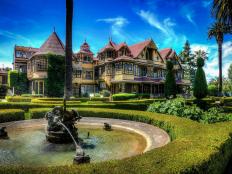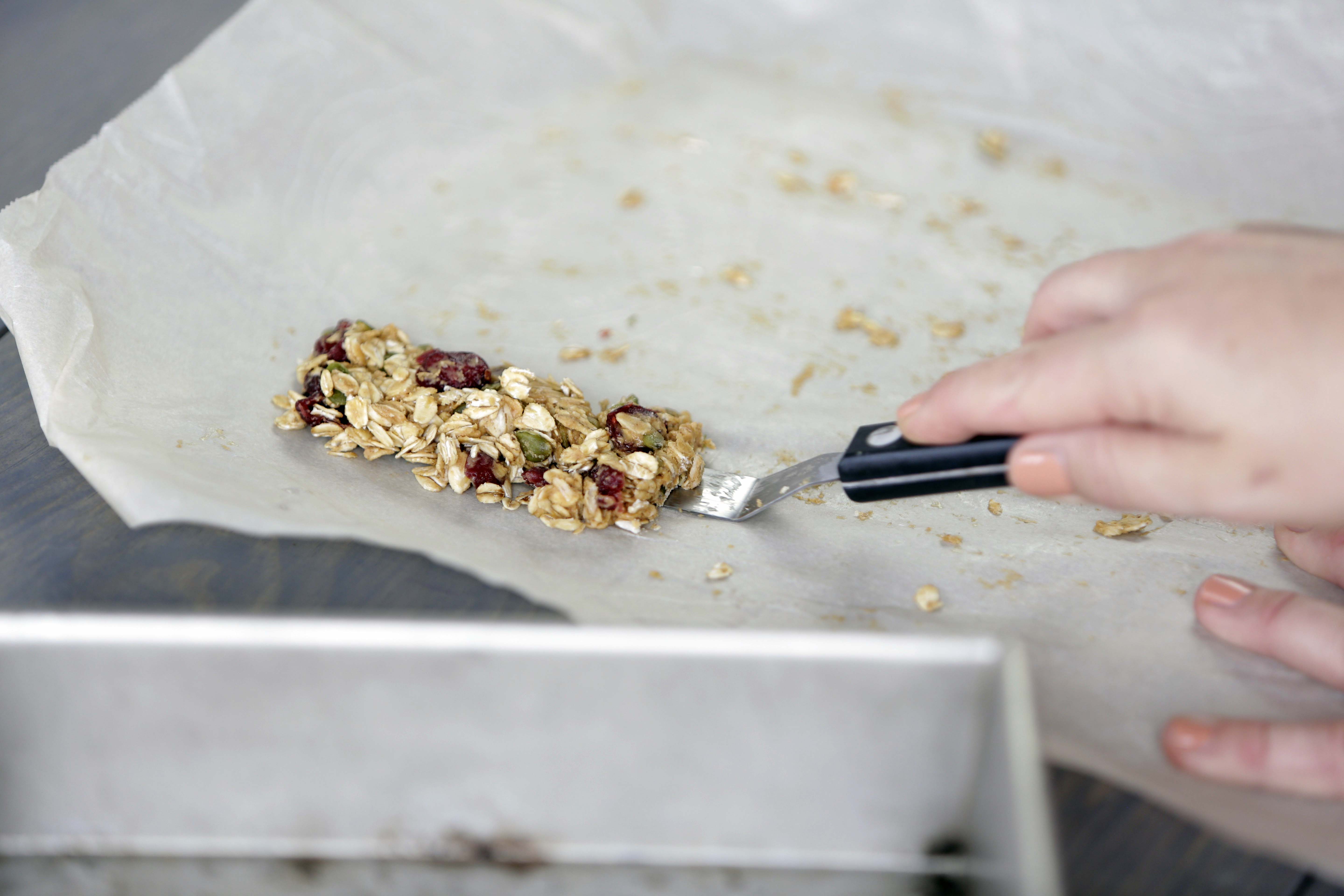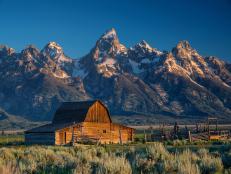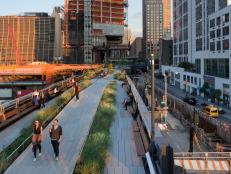Get Your Kicks on Route 66
There was a time in America when you could take one highway – and we’re not talking about a six-lane interstate - all the way from Chicago, Illinois to Santa Monica, California. Route 66, the gateway to the West, first opened in 1926 and reached its zenith in the mid-Fifties before being slowly replaced by the super expressways in the Sixties and Seventies.

Tulsa Regional Chamber/www.visittulsa.com
A journey from the start of the route to the end would take you through an ever-changing landscape of mom-and-pop restaurants and cafes, quirky gift shops, drive-in theaters, motels and motor courts with names like U Drop Inn and John’s Modern Cabins and unusual local attractions like the Blue Whale (pictured above) in Catoosa, Oklahoma. Although the very last section of Route 66 was bypassed by Interstate 40 at Williams, Arizona in 1984, some of the original highway’s attractions and businesses still exist but they won’t be around forever. So grab your camera and hit the road while you can still experience these cultural treasures.

Visit Springfield-Springfield Convention & Visitors Bureau; www.visitspringfieldillinois.com
ILLINOIS
I-55 eventually replaced Route 66 from Chicago to St. Louis but a few survivors from the historic route are still around in downtown Chicago: Lou Mitchell’s Restaurant & Bakery (est. 1923) at 565 W. Jackson Blvd. is famous for its breakfasts and Billy Goat Tavern (est. 1934) at 430 N. Michigan Avenue was immortalized on SNL’s cheezborger skit by John Belushi and Dan Aykroyd. A half-size replica of the Leaning Tower of Pisa, built for a recreation park in 1934, is still visible in Niles. The Gemini Giant, a 30-foot tall statue named after the Gemini space program, stands outside the Launching Pad Drive-in restaurant in Wilmington. Another 30 foot statue, one of Abe Lincoln as a rail splitter can be glimpsed in Springfield and nearby is the Cosy Dog Drive-in (est. 1946), which is said to be the birthplace of the corn dog. Saved from demolition and restored to its original appearance (circa 1949) is the world’s largest catsup bottle, mounted on a water tower in downtown Collinsville.

www.explorestlouis.com
MISSOURI
I-55 switches over to I-44 after your first stop in St. Louis where you can still sample the beloved ice cream sodas, sundaes and “concretes” of Ted Drewes Frozen Custard on 6726 Chippewa (est. 1941). The Jesse James Wax Museum in Stanton is a genuine curiosity and maintains that the famous outlaw wasn’t murdered by the Ford Brothers but died in 1952 under a pseudonym. Nearby is Meramec Caverns, which has been a popular tourist attraction since 1935. For those who prefer something with more personality than a Days Inn, you can still book a vintage cabin at the charming Wagon Wheel Motel (est. 1935) in Cuba. Fireworks, souvenirs and bologna sandwiches are available at the Totem Pole Trading Post in Rolla, one of the last surviving Rt. 66 mom-and-pop operations. Boots Motel (est. 1939) in Carthage is notable for its distinctive Art Deco-Steamline design and is open for business after recent renovations.

Fred T. Billingsley; Jr.; kshistoricroute66.com
KANSAS
Route 66 only traversed a small section of this state between Missouri and Oklahoma but there are still some sights worth seeing as you cross the Kansas border and enter Galena, the inspiration for the fictional community of Route 66 Radiation Springs in the animated film, "Cars." Here you will see Cars on the Route, a restored KanOtex service station that also showcases a fine display of vintage autos. The original Eisler Brothers Store in Riverton (est. 1925) continues to sell groceries, memorabilia and local handicrafts to passing travelers although it is now known as Nelson’s Old Riverton Store. Further west, you cross over the iconic March Arch Rainbow Bridge a.k.a. Bush Creek Bridge (built in 1923) on your way to Baxter Springs where the visitors' center is housed in a beautifully restored Phillips 66 service station.

Tulsa Regional Chamber; www.visittulsa.com
OKLAHOMA
As you head into Oklahoma on I-44, your first Route 66 attraction will be the Coleman Theatre in Miami. The Spanish Revival style venue first opened its doors in 1929 and has since been restored to its original glory with an active calendar of theater and music events. Clanton’s Cafe in Vinita has been serving hearty breakfasts since 1927 and is the site of the World’s Largest Calf Fry Festival & Cook-Off every fall. Ed Galloway’s Totem Pole Park in Foyil is one of the oldest folk art attractions along the route and was created between the years 1937 to 1961. The Blue Whale of Catoosa adorns a popular swimming hole and nearby you can satisfy your pecan fix at The Nut House in Claremore. The iconic 76 foot sculpture of a giant oil man known as the Golden Driller can still be viewed guarding the entrance to the fairgrounds in Tulsa. The fabulous looking Rock Café in Stroud, created out of local sandstone in 1939, continues to serve meals seven days a week. One of the route’s most famous sights, the Round Barn (est. 1898) in Arcadia, was recently restored and is open to visitors.

Amarillo Convention & Visitor Council; www.visitamarillo.com
TEXAS
Stay on I-40 and your first stop will be Shamrock where the once thriving U-Drop Inn and Tower Conoco Station with its Art Deco stylings (circa 1936) have been preserved as a tourist center. Not far from the Mother Road on Highway 83 near Canadian is Aud, the 50 foot long dinosaur created by Gene Cockrell.The Big Texan Steak House (est. 1960) in Amarillo with its gigantic cowboy sign at the entrance is still serving up their famous 72 oz. steaks and outside town, don't miss the iconic Cadillac Ranch (pictured). While passing through Vega, you should check out Dot’s Mini-Museum which is chock full of Western artifacts and Rt. 66 memorabilia. The Midpoint Café (est. 1928) in Adrian is famous for its homemade pies and is well known for being the midpoint between Chicago and Los Angeles on the famous highway.

Jeff Stafford
NEW MEXICO
The first noteworthy stop after you enter the “Land of Enchantment” is Tucumcari where you can spend the night at the cozy Blue Swallow Motel (est. 1939), restored to its original state and listed on the National Register of Historic Places. While you are there, shop for souvenirs at nearby Tee Pee Curios, where a towering white aluminum teepee protrudes from the front facade. In Santa Fe, you can stay at the historic La Fonda Hotel on the plaza (est. 1925) with its Pueblo-style architecture and beautiful hand-carved furniture; it was previously operated by the famous Fred Harvey restaurant/hotel chain featured in the Judy Garland musical, "The Harvey Girls" (1946). Soak in the history and enjoy a drink at Silva’s Saloon in Bernalillo, which went from a bootlegger’s operation to a legit bar in 1933 after prohibition ended. The beautifully preserved El Rancho Hotel & Motel is a must-visit in Gallup and once hosted such Hollywood stars as Clark Gable and John Wayne when westerns were filmed in the surrounding area.

Jeff Stafford
ARIZONA
A popular destination for family vacations during the golden years of Rt. 66, the Petrified Forest National Park was first established in 1906 and is known for its acres of fossilized trees from the dawn of time and The Painted Desert featuring landscapes made colorful by the abundant mineral deposits. Make sure you stop at the Painted Desert Inn, a landmark lodging establishment which is now a museum displaying artifacts from the building’s rich past. In nearby Holbrook, you can spend the night in a wigwam, one of the last in a novelty motel chain known as Wigwam Village. Another former Harvey House property, La Posada in Winslow (est. 1928), has been given a deluxe makeover and offers luxurious rooms, shops, gardens, restaurants and a museum for their guests. The Museum Club in Flagstaff began as a taxidermist shop and trading post in the early 1930s but converted to a night club in 1936 and today the rough hewn structure, which is allegedly haunted, exists as a popular roadhouse and dance club. Delgadillo’s Snow Cap Drive-in in Seligman continues to serve up its signature root beer and milk shake specialities as if it were 1953, the year it first opened.

Santa Monica Travel & Tourism; photo: Joakim Lloyd Raboff
CALIFORNIA
You are now entering the Mojave Desert region and the first stop of interest is the virtual ghost town of Amboy. The entire town was purchased by restaurant chain owner Albert Okura in 2005 and he restored and reopened Roy’s Motel and Café with its distinctive Googie-styled architecture in 2008. It no longer operates as a motel and café but it remains a historic landmark and is great for photo-ops. The jewel that was the Casa Del Desierto in Barstow began as an elegant dining hall/boarding house in 1911 but in later years was almost demolished until a preservation effort restored it to house a train/bus station, the Mother Road Route 66 Museum and the Western America Railroad Museum. Next up is Emma Jean’s Holland Burger Café (est. 1947) in Victorsville where you can treat yourself to one of her signature burgers or a chicken fried steak. Another iconic stop is the Magic Lamp Inn (est. 1955) in Rancho Cucamonga with its rococo roof, stained glass windows and neon sign. Splurge and order a steak dinner here or have a drink in the cool retro lounge. At the end of the road lies the beckoning Santa Monica Pier (circa 1909), a perfect way to end your journey with a day of arcade games, food venues, kiddie rides and the famous wooden horse carousel housed in the Hippodrome.









